
Gobiidae is a family of bony fish in the order Gobiiformes, one of the largest fish families comprising more than 2,000 species in more than 200 genera, sometimes referred to as the "true gobies". Most of them are relatively small, typically less than 10 cm (3.9 in) in length. The Gobiidae includes some of the smallest vertebrates in the world, such as Trimmatom nanus and Pandaka pygmaea, Trimmatom nanus are under 1 cm long when fully grown, then Pandaka pygmaea standard length are 9mm (0.35 in),maximum known standard length are 11 mm (0.43 in). Some large gobies can reach over 30 cm (0.98 ft) in length, but that is exceptional. Generally, they are benthic, or bottom-dwellers. Although few are important as food for humans, they are of great significance as prey species for commercially important fish such as cod, haddock, sea bass, and flatfish. Several gobiids are also of interest as aquarium fish, such as the dartfish of the genus Ptereleotris. Phylogenetic relationships of gobiids have been studied using molecular data.

Amphiprion melanopus, also known as the cinnamon clownfish, fire clownfish, red and black anemonefish, black-backed anemonefish or dusky anemonefish is a widely distributed anemonefish chiefly found in the western and southern parts of the Pacific Ocean.. The species scientific name 'melanopus' is Greek, meaning black feet in reference to the black pelvic fins. Like all anemonefishes it forms a symbiotic mutualism with sea anemones and is unaffected by the stinging tentacles of the host anemone. It is a sequential hermaphrodite with a strict sized based dominance hierarchy: the female is largest, the breeding male is second largest, and the male non-breeders get progressively smaller as the hierarchy descends. They exhibit protandry, meaning the breeding male will change to female if the sole breeding female dies, with the largest non-breeder becomes the breeding male.
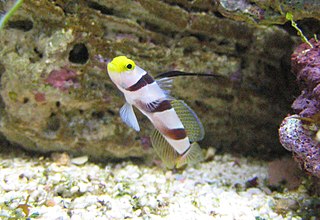
Stonogobiops nematodes, the Filament-finned prawn-goby, the Antenna goby, the high-fin goby, the red-banded goby, the high-fin red-banded goby, the striped goby, the barber-pole goby, or the black-ray Goby, is a species of marine goby native to the Indian Ocean and western Pacific Ocean from the Seychelles to the Philippines and Bali.

Nemateleotris decora, the elegant firefish or purple firefish, is a species of dartfish native to tropical waters in the Indo-West Pacific, from Mauritius to Samoa, north to Ryukyu Islands, and south to New Caledonia, from depths ranging between 25 to 70 m. It is found over hard, open bottoms of reefs, sandy patches and rubble, as well as deeper coastal outer reef drop-offs where there are strong currents. It reaches a maximum length of 9 cm (3 in). This species is often found in pairs and is monogamous. They feed on zooplankton, especially the larvae of copepods and crustaceans. They will dart into holes when alarmed. The populations of this species from the western Indian Ocean have been recognised by some workers as a distinct species, Nemateleotris exquisita, however, the validity of this taxon needs more taxonomic research.
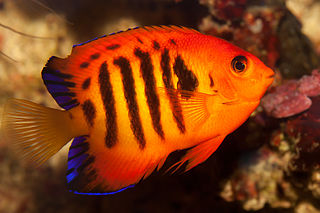
The flame angelfish is a marine angelfish of the family Pomacanthidae found in tropical waters of the Pacific Ocean. Other common names include flame angel, flaming angelfish and Japanese pygmy angelfish.

Amblyeleotris steinitzi, Steinitz' prawn goby or simply Steinitz' goby, is a species of small fish in the family Gobiidae. It lives in association with an alpheid shrimp and is found from the Red Sea through the Indian Ocean to the western Pacific Ocean.

The Gobiiformes are an order of fish that includes the gobies and their relatives. The order, which was previously considered a suborder of Perciformes, is made up of about 2,211 species that are divided between seven families. Phylogenetic relationships of the Gobiiformes have been elucidated using molecular data. Gobiiforms are primarily small species that live in marine water, but roughly 10% of these species inhabit fresh water. This order is composed chiefly of benthic or burrowing species; like many other benthic fishes, most gobiiforms do not have a gas bladder or any other means of controlling their buoyancy in water, so they must spend most of their time on or near the bottom. Gobiiformes means "Goby-like".

Ptereleotris hanae, commonly known as the blue gudgeon dartfish or blue hana goby, is a species of dartfish native to the western Pacific Ocean. It is a reef inhabitant, being found at depths of from 3 to 50 metres, though usually no shallower than 6 metres (20 ft). It inhabits burrows made by alpheid shrimp, but unlike the Amblyeleotris gobies who normally associate with these shrimp, this species has no interactions with their shrimp hosts. This species can reach a length of 12 centimetres (4.7 in) TL. It can also be found in the aquarium trade.

Ptereleotris zebra, the Zebra barred dartfish, Chinese zebra goby, is a species of dartfish native to the Indian Ocean and the western Pacific Ocean. An inhabitant of reefs, it can be found in schools at depths of from 2 to 31 metres though usually no deeper than 4 metres (13 ft). This species can reach a length of 12 centimetres (4.7 in) SL. It can also be found in the aquarium trade.
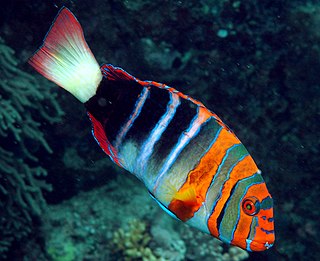
The harlequin tuskfish, Choerodon fasciatus, is a species of wrasse native to the western Pacific Ocean. It occasionally makes its way into the aquarium trade.
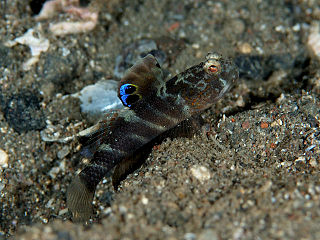
Mahidolia mystacina, the flagfin prawn goby, flagfin shrimpgoby or smiling goby, is a species of goby native to the Indian Ocean and the Pacific Ocean from Delagoa Bay, Mozambique to the Society Islands and from southern Japan to Samoa and northern Australia. This species occurs in marine and brackish waters, being found in coastal bays, estuaries and reef bases where the bottom is silty or muddy at depths of from 5 to 25 metres. This species is a commensal with a species of alpheid shrimp, using its burrow as its home. This species can reach a length of 8 centimetres (3.1 in) TL. This species can also be found in the aquarium trade. It is currently the only known member of its genus.
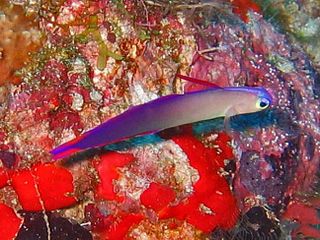
Nemateleotris is a genus of dartfishes native to the Indian and Pacific oceans.
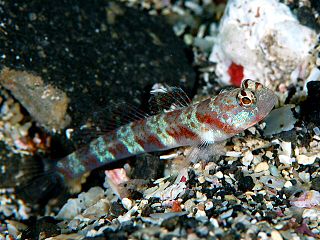
Amblyeleotris periophthalma, the broad-banded shrimp goby or the periophthalma shrimp goby, is a marine benthic species of goby native to reef environments of the Indo-West Pacific, Red Sea included.
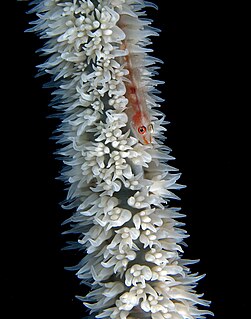
Bryaninops yongei, the wire-coral goby or whip coral goby, is a benthic species of goby widely distributed from the tropical and subtropical waters of the Indian Ocean to the islands in the center of the Pacific Ocean.

Nemateleotris helfrichi, Helfrich's Dartfish, is a species of dartfish native to the Pacific Ocean.
Trimma tevegae, commonly known as the bluestripe pygmygoby or blue-striped cave goby among other names, is a species of goby from the western Pacific. They are small fish, averaging at 2 cm (0.79 in), orange-brown with white undersides in life, with characteristic iridescent blue or lavender stripes on the sides and on top of the body. They are usually found in large schools in the sloping or vertical drop-offs at coral reef edges. They are sometimes caught for the aquarium trade, and are also known by hobbyists under the name blue line flagtail goby. The species is named in honor of the schooner Te Vega.

Heliofungia actiniformis is a solitary species of mushroom coral, a large polyp stony coral in the family Fungiidae. This coral is found in shallow water in the Indo-Pacific region. It is a zooxanthellate species. It is a popular coral in the reef aquarium trade; wild populations are threatened by disease, climate change, and over-collecting, and the species is considered vulnerable by the IUCN.

Cephalopholis sonnerati, known as the tomato hind, tomato rockcod, or tomato cod, is a species of marine ray-finned fish, a grouper from the subfamily Epinephelinae which is in the family Serranidae which also includes the anthias and sea basses. It is distributed on coral reefs in the tropical Indo-Pacific. It is also sometimes called the orange-spotted cod, red coral cod, red rockcod, tomato grouper, or tomato seabass.

Pleurosicya mossambica, also known as the toothy goby or the Mozambique ghost goby, is a small species of goby native to the tropical Indo-West Pacific region. It was first described by South African ichthyologist J.L.B. Smith in 1959. Like many other gobies, it forms commensal relationships with several other marine invertebrates, including soft corals and sponges.
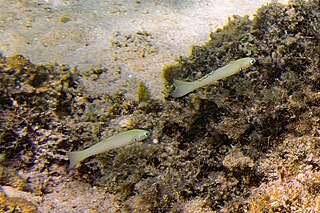
Ptereleotris microlepis is a species of the fish family Gobiidae.




















